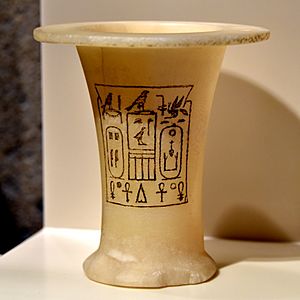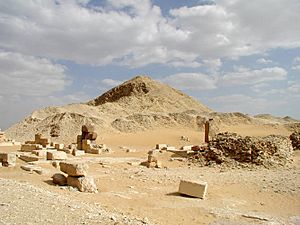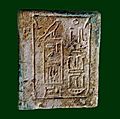Pepi II Neferkare facts for kids
Quick facts for kids Pepi II Neferkare |
|
|---|---|
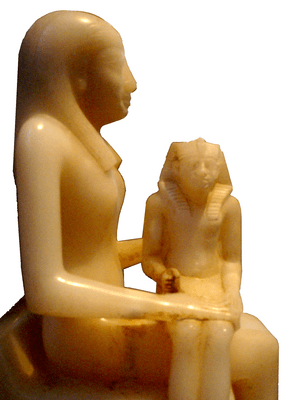
Alabaster statue of Ankhesenmeryre II and her son Pepi II.
|
|
| Pharaoh | |
| Reign | 2278–after 2247 BC, probably either c. 2216 or c. 2184 BC (6th Dynasty) |
| Predecessor | Merenre Nemtyemsaf I |
| Successor | Merenre Nemtyemsaf II |
| Consort | Neith, Iput II, Ankhesenpepi III, Ankhesenpepi IV, Udjebten, and Meritites IV |
| Father | Merenre Nemtyemsaf I or, less probably, Pepi I Meryre |
| Mother | Ankhesenpepi II |
| Born | 2284 BC |
| Died | after 2247 BC, probably c. 2216 BC or c. 2184 BC (older than 37, probably aged 68–100) |
| Burial | Pyramid of Pepi II in Saqqara |
| Monuments | Pyramid of Pepi II |
Pepi II Neferkare was an ancient Egyptian pharaoh who ruled during the Sixth Dynasty of the Old Kingdom. He became king around 2278 BC and his reign lasted for many years. His name, Neferkare, means "Beautiful is the Ka of Re". He became pharaoh when he was only six years old, after his brother Merenre I passed away.
Pepi II's long rule saw a big change in Egypt. The power of the pharaoh started to become weaker, while local governors, called nomarchs, grew stronger. This shift in power eventually led to the end of the Old Kingdom soon after Pepi II's reign.
Contents
Pepi II's Early Life and Family

Many experts now believe Pepi II was the son of Merenre Nemtyemsaf I and Queen Ankhesenpepi II. His mother, Queen Ankhesenpepi II, likely helped him rule when he was very young. She might have had help from her brother, Djau, who was an important official called a vizier.
A special statue in the Brooklyn Museum shows a young Pepi II sitting on his mother's lap. He is wearing his royal clothes. This statue is one of the few artworks we have of Pepi II.
When Pepi II was a child, he showed his adventurous spirit. He wrote a letter to Harkhuf, a governor who led trips to Nubia (a region south of Egypt). Harkhuf had found a pygmy during one of his journeys. The young king was so excited that he promised Harkhuf great rewards if he brought the pygmy back alive. This letter is carved into Harkhuf's tomb and is one of the earliest known travel stories.
Pepi II's Wives and Children
During his long life, Pepi II had several wives. Some of them were:
- Neith: She was the mother of Pepi's son, Merenre Nemtyemsaf II, who became pharaoh after him.
- Iput II: She was Pepi II's half-sister.
- Ankhesenpepi III: She was the daughter of Merenre Nemtyemsaf I.
- Ankhesenpepi IV: She was the mother of a king named Neferkare, but we don't know which one.
- Udjebten: She was also a daughter of Pepi I.
- Meritites IV: She was another wife and a daughter of Pepi I.
Three of his queens—Neith, Iput, and Udjebten—each had their own small pyramids and temples next to Pepi II's main pyramid in Saqqara. These queens' pyramids also contained special writings called Pyramid Texts.
Pepi II also had two other known sons: Nebkauhor-Idu and Ptahshepses.
Egypt's Foreign Relations
Pepi II continued to deal with other lands much like the pharaohs before him. Egypt mined copper and turquoise in the Sinai desert and alabaster stone from Hatnub. His name has been found in writings in the ancient city of Byblos in Phoenicia (modern-day Lebanon).
To the south, Egypt traded with the people of Nubia. Harkhuf, the governor, led many trips to Nubia. From Nubia, Egypt received valuable goods like incense, ebony wood, animal skins, and ivory.
Caravan routes also crossed the Western desert, allowing trade with oases like Kharga Oasis, Selima Oasis, and Dakhla Oasis.
The Decline of the Old Kingdom
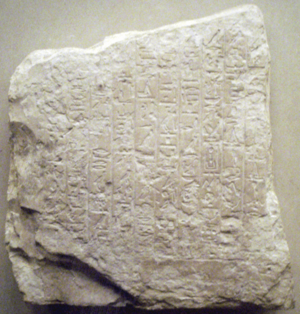
The Old Kingdom started to weaken even before Pepi II became pharaoh. Local governors, known as nomarchs, became more and more powerful. For example, Pepi I married two sisters who were daughters of a nomarch, and he made their brother a vizier. These families became very influential.
During Pepi II's reign, high officials gained more wealth and power. They built large, expensive tombs in their local areas. These nomarchs were usually free from taxes, and their positions were passed down through their families. As they became richer and more independent, the central power of the pharaoh in Memphis became less important.
Later in his reign, Pepi II even divided the important role of vizier into two. There was one vizier for Upper Egypt and another for Lower Egypt. This further spread out the power from the royal capital.
How Long Did Pepi II Rule?
Pepi II is often said to be the longest-reigning ruler in history. An ancient historian named Manetho claimed he ruled for 94 years. However, many modern experts believe his reign was shorter, perhaps around 64 years.
The latest records from Pepi II's time show dates up to his "Year after the 31st Count." If these "counts" happened every two years, it means he ruled for at least 62 years. While a 94-year reign is possible, most historians think it's more likely he ruled for about 64 years. The end of his reign was a difficult time for Egypt, which might explain why fewer records exist from his later years.
Pepi II's Pyramid Complex
Pepi II built a large pyramid complex for himself in Saqqara. It included his pyramid and a temple next to it. The pyramid was made of limestone and covered with white limestone. Inside, his burial chamber had a ceiling painted with stars. His coffin was made of black granite and had his name carved on it.
Near Pepi's pyramid, smaller pyramids were built for his queens: Neith, Iput, and Udjebten. Each queen's pyramid had its own small chapel and temple. Neith's pyramid was the largest of these.
The temple next to Pepi's pyramid was decorated with scenes showing the king. Some scenes showed him hunting a hippopotamus, which symbolized his victory over chaos. Other carvings showed important festivals and Pepi defeating a Libyan chief.
The pyramid itself was about 78.5 meters (257 feet) on each side at its base and 52.5 meters (172 feet) high. It was built using local stones and covered with a layer of limestone. Over time, this outer layer was removed, and the pyramid's core has partly collapsed.
Exploring the Pyramid
The pyramid complex was first looked at by John Shae Perring. Later, Gaston Maspero was the first person to actually go inside the pyramid in 1881. The most detailed study of the complex was done by Gustave Jéquier between 1926 and 1936. He found many parts of the tomb's decorations and published important reports about his discoveries.
Statues of Pepi II
A famous statue in the Brooklyn Museum shows Queen Ankhenesmerire II holding her son Pepi II on her lap. Pepi II is wearing a royal headdress and a kilt. He is shown much smaller than his mother, which is unusual for a king. This might show that his mother was ruling for him when he was very young.
Another statue of Pepi II is in the Egyptian Museum in Cairo. This one shows the king as a naked child. This might represent how young he was when he became pharaoh.
Who Ruled After Pepi II?
After Pepi II, there are not many clear records of the next pharaohs. It is believed that his son, Merenre Nemtyemsaf II, ruled for a short time. Then, a pharaoh named Neitiqerty Siptah might have taken the throne. Some ancient stories also say that Queen Nitocris became the first female ruler of Egypt after Pepi II.
These changes marked the end of the Old Kingdom. After this, Egypt entered a period known as the First Intermediate Period, which lasted for about 200 years.
Images for kids
See also
 In Spanish: Neferkara Pepy para niños
In Spanish: Neferkara Pepy para niños


